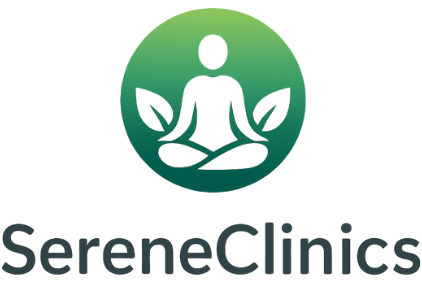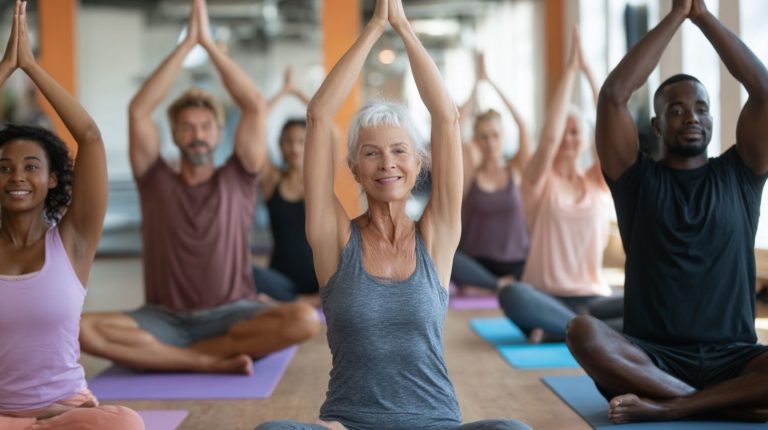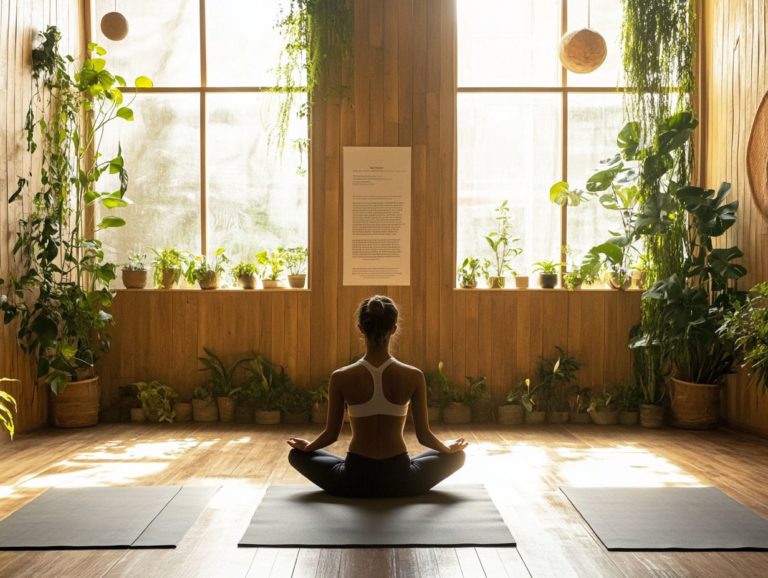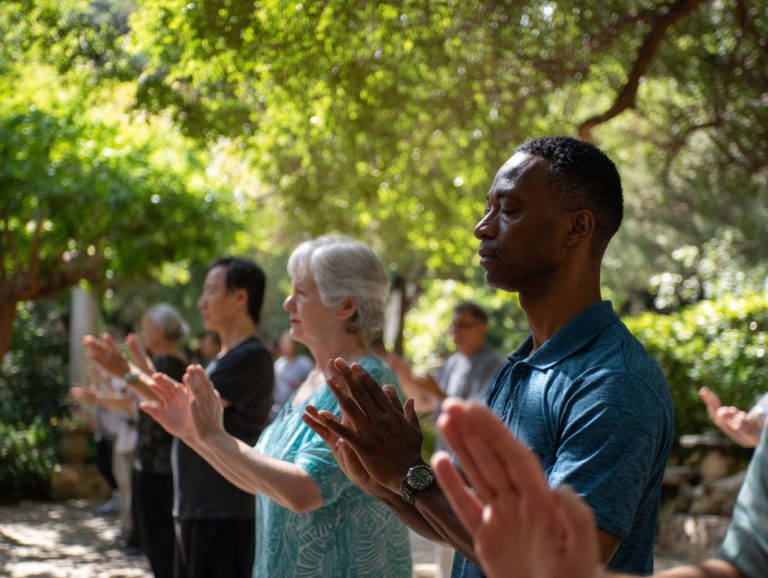Yoga vs. Tai Chi: Practices, Techniques, and Wellness Outcomes
Yoga and Tai Chi, two ancient practices rooted in mindfulness and movement, offer unique pathways to physical and mental wellness.
While both disciplines emphasize the connection between mind and body, they each present distinct styles, techniques, and health benefits.
This article covers the basics of Yoga and Tai Chi, comparing their similarities and differences in practice, techniques, and wellness outcomes.
Whether you’re looking to improve your health or address particular health issues, understanding these practices can help you make decisions that benefit your health goals.
Key Takeaways:
Contents
- 1 What is Yoga?
- 2 What is Tai Chi?
- 3 How are Yoga and Tai Chi Similar?
- 4 How are Yoga and Tai Chi Different?
- 5 Which Practice is Better for Overall Wellness?
- 6 Health Benefits of Tai Chi and Qigong
- 7 Which Practice is Better for Specific Health Concerns?
- 8 How to Choose Between Yoga and Tai Chi?
- 9 Frequently Asked Questions
- 9.1 What is the difference between yoga and Tai Chi?
- 9.2 Which practice is better for flexibility?
- 9.3 Can yoga and Tai Chi improve mental wellness?
- 9.4 Which practice is better for strength building?
- 9.5 Are there any risks associated with practicing yoga or Tai Chi?
- 9.6 Which practice is better for overall wellness?
What is Yoga?
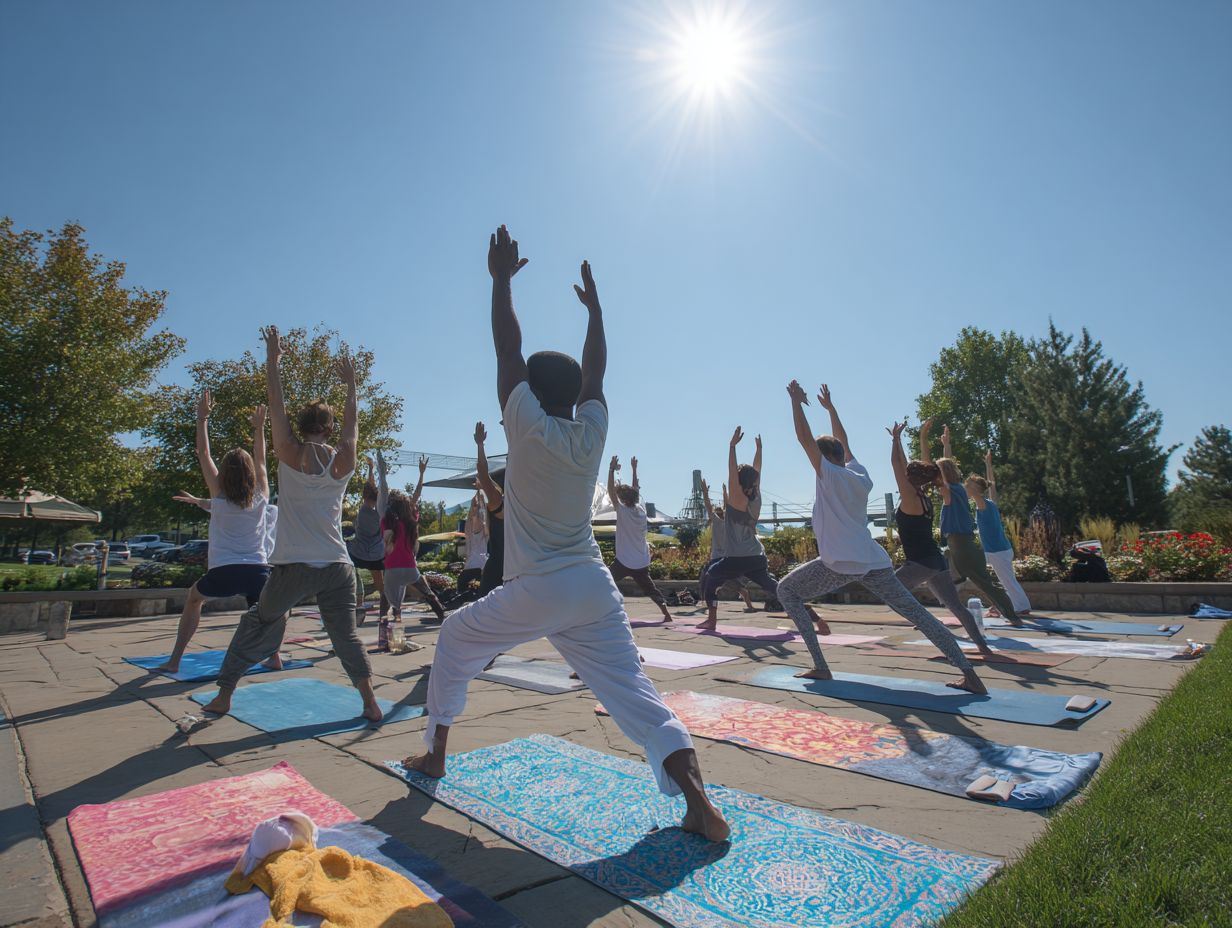
Yoga is a time-honored practice from ancient India that includes physical exercises, breathing methods, and mindfulness activities to improve overall health.
By combining the mind and body, yoga helps increase flexibility, strength, and mental focus while offering many health benefits, like reducing stress and enhancing physical well-being.
With different styles such as Hatha Yoga and restorative yoga, individuals can choose a yoga routine that suits their personal taste and wellness path. For a deeper understanding of yoga’s philosophical roots and practices, Wikipedia provides a detailed overview of Yoga philosophy.
What are the Different Types of Yoga?
There are various types of yoga, each offering distinct benefits and approaches, such as Hatha Yoga, which focuses on physical postures and alignment, and restorative yoga, which emphasizes relaxation and stress relief.
Plus these, Vinyasa Yoga allows practitioners to flow through sequences of movements that are synchronized with breath, promoting cardiovascular health and enhancing flexibility.
On the other hand, Ashtanga Yoga is a strong and active type of yoga, with a fixed sequence of poses that test your strength and endurance.
For those looking to improve mindfulness and meditation, Yin Yoga provides a slower practice where poses are held longer, allowing for deeper tissue stretching and emotional release. According to ResearchGate, different types of yoga can offer unique physiological and psychological benefits, supporting the versatility and effectiveness of yoga practices.
These activities help improve physical fitness, clear thinking, emotional balance, and a strong feeling of health. If interested, you might explore the various types and requirements for yoga certifications which can deepen your understanding and practice.
What is Tai Chi?
Tai Chi is an old martial art from China, recognized for its slow and smooth movements that help with internal energy flow and improve both body and mind.
Often referred to as ‘moving meditation,’ Tai Chi emphasizes being mindful and relaxed, making it excellent for lowering stress and improving overall health.
Its exercises help increase muscle strength, flexibility, and balance, leading to improved physical health, as highlighted by Medical News Today. Related insight: Yoga and Tai Chi – Serene Clinics
What are the Different Styles of Tai Chi?
Tai Chi includes different styles. The most well-known is Yang Style Tai Chi, which emphasizes slow and steady movements to improve balance and flexibility. Chen Style is also notable for energetic movements and intense exercises created by Chen Wangting.
Another notable style is Wu Style, characterized by its compact frame and softness, which promotes a relaxed, meditative experience while enhancing joint stability.
Each of these forms brings its unique techniques that cater to different preferences and physical abilities, allowing practitioners worldwide to enjoy the soothing yet invigorating flow of Tai Chi.
Learning this martial art improves concentration and is good for your heart, providing a useful way to improve health.
By trying these different styles, people can use their natural energy, creating a stronger link between body and mind.
How are Yoga and Tai Chi Similar?
Yoga and Tai Chi have much in common. Both are ancient practices that improve health through specific movements, breathing exercises, and relaxation techniques. These activities encourage mindfulness and lessen stress, helping people improve their mental focus and overall wellness.
They stress the connection between mind and body, urging people to stay aware of their bodies and the flow of energy, which is crucial for understanding the broader spectrum of yoga certifications and requirements as mentioned in related practices.
What are the Similarities in Practice?
Both Yoga and Tai Chi are practices focused on careful movements. They improve physical health with a series of poses and smooth actions that increase flexibility, balance, and muscle strength.
These practices help people develop a strong sense of body awareness, enabling them to align their mind and body smoothly.
When people engage in these calm, careful movements, they often find a way to reduce stress, promoting a sense of peace that benefits overall health.
Also, both areas focus on controlled breathing, which helps increase relaxation and improves the meditative aspect of the activity.
This combination of movement, mindfulness, and breath improves physical health and helps with emotional balance and mental clarity.
What are the Similarities in Techniques?
Yoga and Tai Chi use similar methods that focus on controlled breathing, specific physical positions, and purposeful movement to develop energy flow and improve awareness.
Both practices focus on breathing methods that are essential. In Yoga, practitioners often engage in pranayama, focusing on various breath control methods to channel energy and create a sense of inner calm.
Meanwhile, Tai Chi practitioners prioritize slow, deliberate movements synchronized with deep, rhythmic breathing, allowing for a harmonious flow of energy throughout the body.
These techniques help improve physical health by increasing flexibility and strength and play an important role in achieving mental clarity. Many people who engage in these mindful exercises often say they feel more relaxed, have less stress, and feel more connected to themselves.
What are the Similarities in Wellness Outcomes?
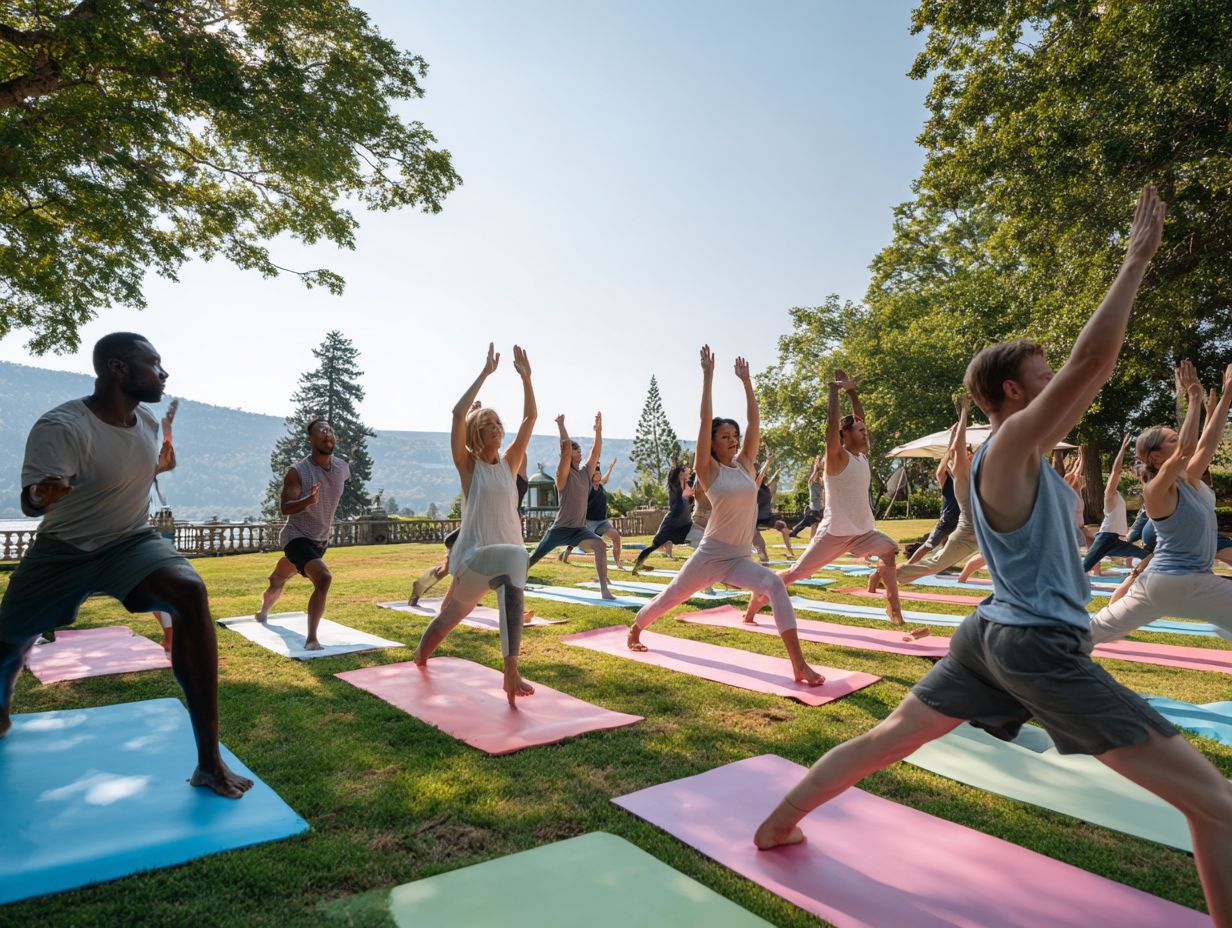
Both Yoga and Tai Chi provide similar health benefits, such as better physical fitness, clearer thinking, and reduced stress, which help with overall wellness.
Engaging in these practices can lead to better flexibility and balance, promoting a sense of harmony within the body. Individuals often report increased energy levels alongside a reduction in anxiety and stress.
The flowing motions of Tai Chi can relax the mind, leading to clearer thinking and better concentration. In Yoga, breathing exercises help center individuals, encouraging a stronger link to their inner selves.
These activities benefit the body in gentle but effective ways, while improving emotional resilience and awareness, enhancing daily life and relationships.
How are Yoga and Tai Chi Different?
Yoga and Tai Chi have things in common, but they also have key differences in their exercises, methods, and health benefits.
Yoga often involves holding positions and focusing on deep breathing to improve flexibility and find mental calm.
In contrast, Tai Chi involves smooth, flowing movements and uses martial arts ideas to encourage energy movement and balance.
What are the Differences in Practice?
Yoga often includes holding physical positions for a long time, while Tai Chi is a smooth sequence of movements that improves balance and coordination.
The structured yet diverse poses in Yoga are designed to improve flexibility, strength, and mental focus, allowing practitioners to deepen their awareness of body and breath.
In contrast, Tai Chi’s gentle, rhythmic motions promote a sense of calm and mindfulness, inviting a meditative quality into the movements.
Each method offers unique paths to relaxation, with Yoga focusing on stillness and introspection through static positions, while Tai Chi encourages fluidity and grace, inviting individuals to connect more harmoniously with their environment.
This difference improves their practices, meeting various preferences and physical needs.
What are the Differences in Techniques?
Yoga techniques often emphasize deep diaphragmatic breathing paired with static postures, while Tai Chi focuses on synchronized breath with fluid movements that promote energetic practices.
These unique methods greatly affect how people practice yoga, encouraging them to grow in awareness and calmness. This often results in a meditative state that supports mindfulness and emotional stability.
Tai Chi connects breathing and movement, helping people increase their inner energy, called ‘qi,’ which improves blood circulation and overall health.
Both methods, though they are done differently, highlight the significant effect of mindful breathing and purposeful movement on general well-being, providing different ways to promote relaxation and energy in today’s life.
What are the Differences in Wellness Outcomes?
Yoga and Tai Chi provide different health benefits. Yoga usually helps increase flexibility and clear the mind. Tai Chi is good for better balance and lowering ongoing stress.
When examining the particular health benefits of these two practices, it’s clear that Yoga often stands out in building physical strength and improving mental concentration. This makes it popular among those wanting to improve their mind-body connection.
Meanwhile, people who practice Tai Chi often notice improvements in their joint health and posture, which helps reduce falls in older adults.
Each activity offers its own benefits. For example, many people practice Yoga to improve their self-awareness or emotional resilience, while Tai Chi is recognized for its gentle exercises that support heart health.
Individuals may choose one or the other based on their personal health goals and areas of wellness they wish to improve.
Which Practice is Better for Overall Wellness?
Choosing between Yoga and Tai Chi for wellness largely depends on what someone likes and their health requirements.
Both Yoga and Tai Chi provide specific benefits like improving flexibility, reducing stress, and clearing the mind (our Holistic Health guide delves deeper into these practices and their overall impact).
What are the Benefits of Yoga for Wellness?
Yoga provides many benefits for wellness, including better physical health by increasing flexibility and muscle strength, along with clear thinking and effective stress reduction.
Practicing yoga regularly helps you build strength and teaches breathing methods that improve oxygen circulation, important for your health.
This age-old practice links the body, mind, and spirit, offering a complete method for health and well-being. Participants often become more aware of the present moment, helping them develop a mindset focused on the now.
As a result, individuals can manage stress and anxiety more effectively, leading to a more tranquil mindset. People often say they see improvements in handling insomnia, better sleep, and staying emotionally steady, all of which are key parts of a healthy way of living.
What are the Benefits of Tai Chi for Wellness?
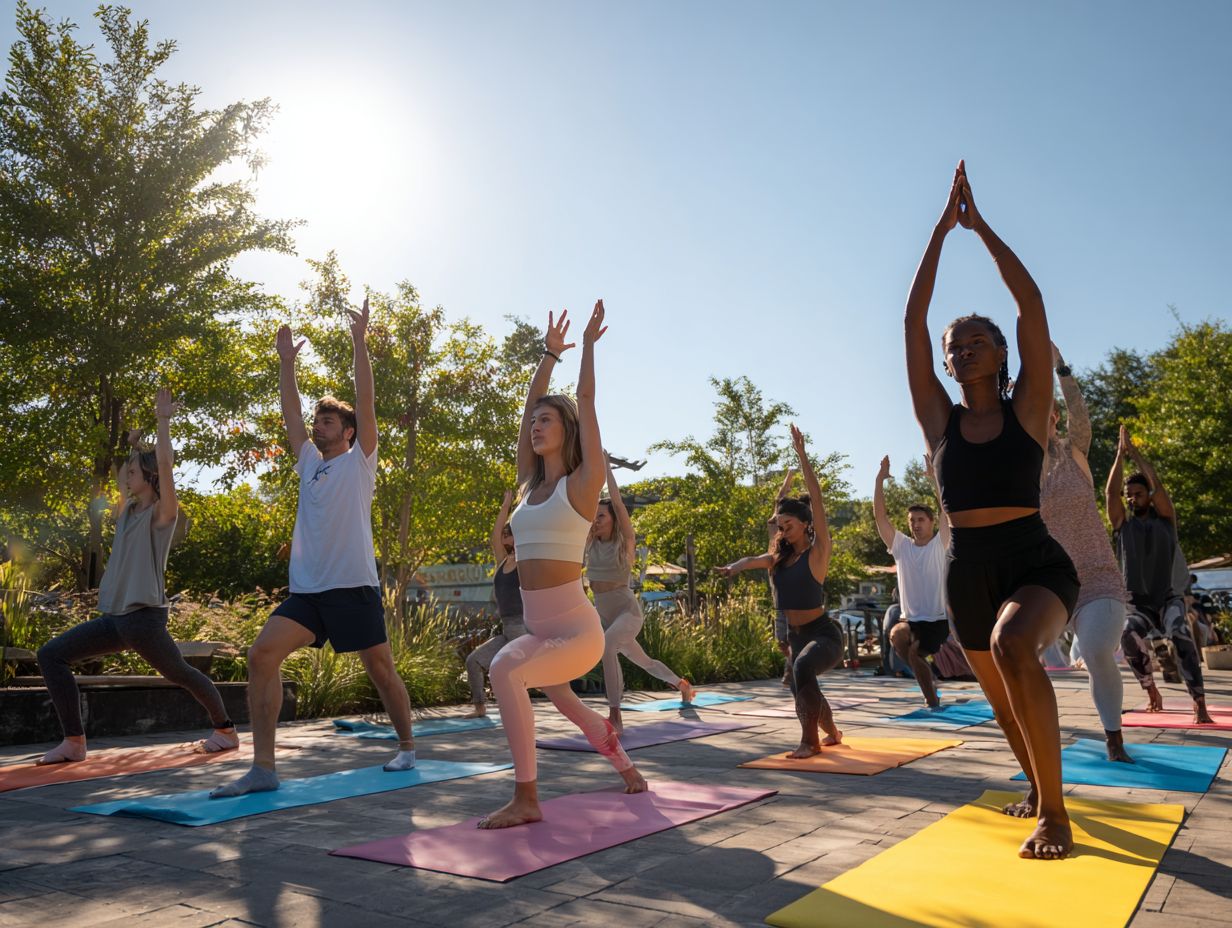
Tai Chi is renowned for its health benefits, particularly in improving balance, reducing stress levels, and enhancing overall physical fitness through its gentle movements and focus on body awareness.
By engaging in this ancient practice, individuals find themselves cultivating a greater sense of stability and coordination, which can significantly decrease the risk of falls, especially in older adults.
The calming parts of Tai Chi help you relax, reduce anxiety, and clear your mind.
As one practices the smooth movements and breathing methods, the body gains better muscle strength and flexibility, leading to greater ease of movement and general health.
Adding Tai Chi to your daily routine improves both physical health and emotional strength, providing a well-rounded method for overall well-being.
Health Benefits of Tai Chi and Qigong
Health Benefits of Tai Chi and Qigong
Effectiveness of Tai Chi and Qigong: Psychological and Physiological Improvements
Effectiveness of Tai Chi and Qigong: Percentage of Health Benefits
The dataset on the Health Benefits of Tai Chi and Qigong offers useful information on how these old methods benefit mental and physical health. Tai Chi and Qigong are well-known for promoting overall health and are gaining more attention for their positive effects on different health issues.
Effectiveness of Tai Chi and Qigong is evidenced by multiple studies that highlight significant benefits:
- Cardiopulmonary Effects: Out of the studies conducted, 19 have reported improvements in cardiopulmonary health. This suggests that these activities might support breathing and heart health, probably because of the slow movements and focus on deep breathing.
- Physical Function Improvements: 16 studies Regular practice has shown improvements in how well people move, how flexible they are, and their general physical abilities.
- Psychological Symptoms Reductions: With 27 studies reporting reductions in psychological symptoms, Tai Chi and Qigong are shown to effectively alleviate conditions such as anxiety, depression, and stress, promoting mental health.
- Balance and Fall Prevention: 24 studies Emphasize better stability and steps to prevent falls, which are important for older adults. These improvements help them stay independent and lessen the chance of getting hurt.
The Percentage of Health Benefits further illustrates these practices’ impact:
- Physiological/Psychological Benefits: A significant 69.2% The health benefits involve physical and mental improvements, highlighting how Tai Chi and Qigong contribute to better health.
- Quality of Life Improvements: 36.2% Some benefits are linked to better quality of life, showing improvements in everyday tasks and emotional health.
- Immune Function and Inflammation Reduction: 23.1% Some benefits include improved immune system performance and decreased inflammation, which are important for preventing and managing illnesses.
Overall, the data shows that adding Tai Chi and Qigong to regular health habits can provide significant health benefits, helping both mental and physical health for different groups of people. These practices improve your health right away and also lead to better health and quality of life over time.
Which Practice is Better for Specific Health Concerns?
When looking at specific health issues, both Yoga and Tai Chi provide specific benefits. It’s important to know which practice is better for your personal needs.
What are the Benefits of Yoga for Specific Health Concerns?
Yoga has been shown to provide significant benefits for specific health concerns, such as chronic stress, anxiety, and various physical conditions, through its focus on relaxation techniques and mindfulness.
This traditional activity encourages deep breathing and physical movement, helping people connect their mind and body, which can be important for those dealing with stress-related issues.
Including postures that increase flexibility and strength helps reduce tension in areas often affected by long-term pain or discomfort.
Practicing yoga regularly can help clear your mind and balance your emotions, which may reduce anxiety and improve your well-being.
What are the Benefits of Tai Chi for Specific Health Concerns?
Tai Chi offers beneficial outcomes for specific health concerns, particularly in enhancing balance, promoting cardiovascular fitness, and reducing stress through its gentle, mindful movements.
This traditional approach allows individuals to perform light exercises that improve balance, making it a suitable choice for those concerned about falls or mobility issues.
Practicing Tai Chi often can lower blood pressure and improve circulation, benefiting the heart and blood vessels.
Its meditative nature helps individuals manage anxiety and stress, promoting mental well-being.
By practicing these movements, participants can become more aware of the present moment, increase their energy, and experience greater calmness in daily life.
How to Choose Between Yoga and Tai Chi?

Choosing between Yoga and Tai Chi means thinking about what you like, your health goals, and what each practice can do for your personal wellness.
What Factors Should Be Considered?
When choosing between Yoga and Tai Chi, people should think about their own likes, what health improvements they want, and the health benefits each activity offers.
Each practice has specific benefits that address various parts of a person’s wellness routine.
For example, people wanting a tough exercise routine might choose Yoga. It can improve flexibility, strength, and balance with different poses and sequences.
On the other hand, people who prefer a gentle exercise might like Tai Chi. Its slow, smooth movements help with relaxation and mindfulness while also offering physical benefits.
One’s current fitness level, stress management needs, and the desire for a meditative aspect can greatly influence this decision.
The decision should match what feels right for you, helping with overall health and wellness.
Frequently Asked Questions
What is the difference between yoga and Tai Chi?
Yoga and Tai Chi are both physical practices that promote overall wellness, but they differ in their origins and techniques. Yoga originated in India and involves holding specific poses and practicing controlled breathing. Tai Chi originated in China and involves a series of slow and fluid movements that focus on balance and mindfulness.
Which practice is better for flexibility?
Both yoga and Tai Chi can improve flexibility, but yoga may be more effective due to its emphasis on holding poses for longer periods of time. Yoga includes various stretches like forward bends and backbends, focusing on certain muscle areas. However, the slow and smooth moves of Tai Chi can improve flexibility over time.
Can yoga and Tai Chi improve mental wellness?
Yes, both practices have been shown to have a positive impact on mental wellness. Yoga’s focus on breathing and mindfulness can help reduce stress and anxiety, while Tai Chi’s meditative movements can promote relaxation and increase self-awareness.
Which practice is better for strength building?
Yoga and Tai Chi both offer strength-building benefits, but they use different techniques. Yoga uses body weight and holds poses to build strength, while Tai Chi uses slow, controlled movements to engage muscles and improve balance. In the end, the most effective way to build strength might vary based on personal likes and objectives.
Are there any risks associated with practicing yoga or Tai Chi?
In general, both practices are considered safe for most people. It’s important to listen to your body and avoid pushing yourself too hard, particularly if you’re new to these activities. It is also recommended to consult with a healthcare professional before starting any new physical activity.
Which practice is better for overall wellness?
Both yoga and Tai Chi can contribute to overall wellness in different ways. Yoga may be better for increasing flexibility and strength, while Tai Chi may be better for improving balance and mindfulness. It’s really a personal choice, and including both practices in your routine can give you a balanced way to stay healthy.

Sheetal Sharda has a background in CS. She got an interest in Holistic living back in 2018, and has since started exploring more into Naturapathy, Holistic Living, Yoga, and more. She got inspired to start SereneClinics to help people find reliable centers across the world.
